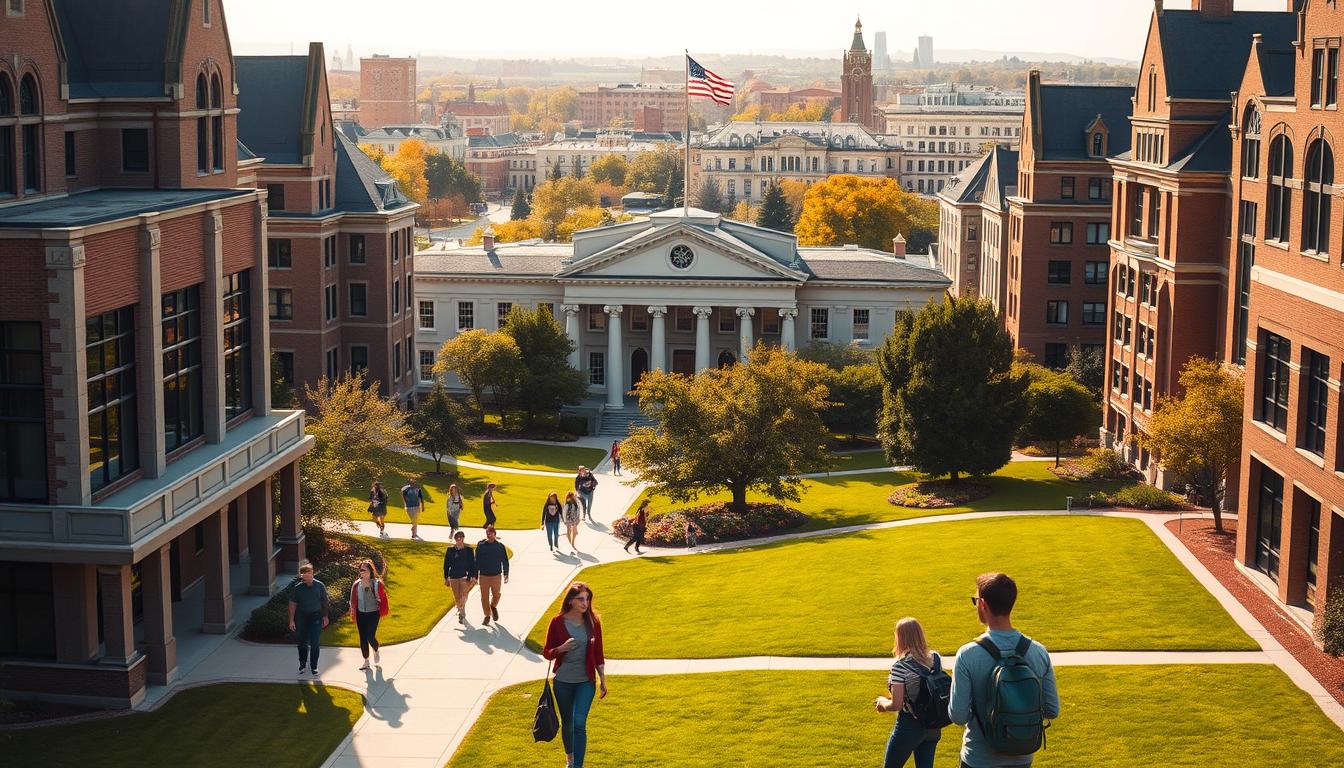Your guide to US scholarships, student visas, and top universities — everything international students need to start their study journey
For international students, studying in the US can be a dream come true. With its world-class universities and diverse academic programs, the US offers a unique educational experience. However, navigating the complexities of US higher education can be challenging.

This article aims to provide a comprehensive guide for international students, covering essential topics such as scholarships, visa guides, and top universities in the US. Whether you’re just starting your research or are ready to apply, this guide will help you make informed decisions about your educational journey.
Key Takeaways
- Overview of scholarships available for international students
- Step-by-step guide to obtaining a US student visa
- Ranking of top universities in the US for international students
- Tips for navigating the US higher education system
- Insights into the benefits of studying in the US
Understanding the US Higher Education System
Understanding the structure and nuances of the US higher education system is crucial for students looking to study abroad. The system is characterized by its diversity, with various types of institutions offering a wide range of academic programs.
Types of Institutions in the United States
The US is home to over 4,700 institutions, including community colleges, liberal arts colleges, public and private universities, and specialized institutions. As “The US higher education system is known for its flexibility and variety,” catering to different academic and career goals.
Academic Calendar and Degree Programs
Most US institutions follow a semester or quarter system. They offer various degree programs, including associate’s, bachelor’s, master’s, and doctoral degrees, as well as certificate programs. The flexibility in course selection allows students to tailor their education to their interests and career aspirations.
Accreditation and Quality Assurance
Accreditation is a critical aspect of the US higher education system, ensuring that institutions meet certain standards of quality.
“Accreditation is a mechanism to ensure that institutions provide high-quality education.”
It is essential for students to verify the accreditation status of their chosen institution.
Navigating Scholarships, Visa Guides, and Top Universities in the US
For international students, understanding the interplay between scholarships, visa guides, and university selection is crucial for a successful US education.
The process of securing scholarships, obtaining the right visa, and choosing a top university are interconnected aspects that can significantly impact an international student’s academic journey.
The Connection Between Scholarships, Visas, and University Selection
Securing a scholarship can greatly influence one’s ability to obtain a student visa, as it demonstrates financial support. Similarly, the choice of university can affect both scholarship opportunities and visa application processes.
As “The right university can open doors to numerous opportunities, including scholarships and a smoother visa application process.”
Planning Timeline for International Students
Creating a planning timeline is essential for international students. It is recommended to start the application process at least 12-18 months in advance.
- Research and shortlist potential universities and scholarships (6-12 months before)
- Prepare and submit applications for scholarships and universities (6-9 months before)
- Apply for a student visa after receiving university acceptance (3-6 months before)
Resources for International Student Support
Several resources are available to support international students, including university counseling services, online forums, and educational consultants.
“With the right guidance and resources, international students can navigate the complex process of securing scholarships, understanding visa requirements, and selecting the right university.”
— Educational Consultant
By understanding the connection between scholarships, visa guides, and top universities, and by planning ahead, international students can make their US education journey smoother and more successful.
Merit-Based Scholarships for International Students
Merit-based scholarships play a crucial role in enabling international students to achieve their academic goals in the United States. These scholarships are awarded based on academic excellence, talent, or other achievements, providing opportunities for students to pursue higher education without the burden of financial constraints.
Fulbright Foreign Student Program
The Fulbright Foreign Student Program is one of the most prestigious scholarship programs for international students. It offers grants for graduate study, research, or teaching assistantships in the US. The program is designed to promote cultural exchange and mutual understanding between the US and other countries. To be eligible, applicants must demonstrate academic excellence, English proficiency, and a commitment to representing their home country in the US.
University-Specific Merit Scholarships
Many top universities in the US offer merit-based scholarships to attract talented international students. These scholarships can cover partial or full tuition fees and sometimes include additional benefits like stipends or assistantships. Universities such as Harvard, Stanford, and MIT have specific merit scholarship programs for international students, often requiring a strong academic record and standardized test scores.
Private Foundation Scholarships
Private foundations also play a significant role in providing merit-based scholarships to international students. Organizations like the Rotary Foundation and the Aga Khan Foundation offer scholarships that not only support tuition but also promote global understanding and leadership. These programs often have specific eligibility criteria and application deadlines.
Application Strategies for Competitive Scholarships
Applying for merit-based scholarships can be highly competitive. To increase their chances, students should start by researching available scholarships early and understanding the specific requirements of each program. It’s crucial to maintain a strong academic record, prepare for standardized tests, and craft compelling application essays that highlight their achievements and goals.
By focusing on these strategies and exploring the various merit-based scholarship opportunities, international students can enhance their prospects of securing financial support for their studies in the US.
Need-Based Financial Aid and Alternative Funding Sources
The journey to securing financial aid for studying in the US involves exploring need-based assistance, work-study opportunities, and country-specific funding programs. International students often face unique financial challenges, but there are various resources available to help.
Understanding Need-Based Aid for International Students
Need-based financial aid is awarded based on a student’s financial need rather than academic achievement. While many US universities have limited need-based aid for international students, some institutions offer substantial support. For instance, Harvard University and Yale University have need-based financial aid programs that cover 100% of demonstrated need for all students, including international students.
Work-Study Opportunities and Campus Jobs
Work-study programs and campus jobs provide international students with valuable work experience and a source of income to help cover living expenses. These opportunities can be found in various departments across campus, such as libraries, research labs, and administrative offices. Students on F-1 visas are allowed to work up to 20 hours per week during the academic year and full-time during breaks, provided they have the necessary authorization.
Country-Specific Funding Programs
Some countries offer funding programs for their citizens to study abroad. For example, the Fulbright Program provides funding for international students to study in the US, though it’s more commonly known for US students studying abroad. However, some countries have their own versions of the Fulbright Program or similar initiatives. Students should research government-sponsored programs in their home countries.
Emergency Financial Assistance
Many universities offer emergency financial assistance to students facing unexpected financial hardships. This can come in the form of emergency loans or grants. International students should familiarize themselves with their university’s student support services to understand what options are available. For instance, some universities have emergency financial assistance programs specifically for international students.
In conclusion, while the primary focus is often on merit-based scholarships, international students should also explore need-based financial aid, work-study opportunities, and other alternative funding sources to support their education in the US.
Complete Guide to US Student Visa Types
For international students aspiring to study in the US, understanding the different types of student visas available is essential. The United States offers various visa options, each catering to different academic and professional goals.
F-1 Student Visa Requirements and Process
The F-1 visa is the most common type of student visa, issued to international students enrolled in academic programs at accredited US institutions. To qualify, students must be accepted into a full-time program and demonstrate sufficient financial resources.
F-1 Visa Key Requirements:
- Acceptance into a full-time academic program
- Proof of financial support
- Maintenance of valid SEVIS status
J-1 Exchange Visitor Visa
The J-1 visa is designed for exchange visitors, including students participating in exchange programs. It requires sponsorship from the US institution or organization hosting the student.
J-1 Visa Highlights:
- Sponsored by a US institution or organization
- May include work opportunities as part of the program
- Duration varies based on the program
M-1 Vocational Student Visa
The M-1 visa is for students enrolled in vocational or technical programs. It’s ideal for those seeking practical training in a specific field.
M-1 Visa Requirements:
- Enrollment in a vocational or technical program
- Proof of financial support
- Limited to the duration of the program
Dependent Visas for Family Members
Family members of student visa holders can accompany them to the US on dependent visas. The type of dependent visa depends on the primary visa holder’s status.
| Primary Visa | Dependent Visa Type |
|---|---|
| F-1 | F-2 |
| J-1 | J-2 |
| M-1 | M-2 |
Understanding the different types of US student visas and their requirements is crucial for a smooth transition to studying in the United States. By choosing the right visa category, international students can ensure compliance with US immigration regulations and focus on their academic pursuits.
Visa Application Process and Interview Preparation
Understanding the intricacies of the US visa application process is crucial for international students planning to study in the US. The process involves several steps, from preparing the necessary documentation to acing the visa interview.
Preparing Documentation for Your Visa Application
The first step in the visa application process is gathering the required documents. This typically includes a valid passport, the DS-160 confirmation page, a passport-sized photograph, and the SEVIS fee receipt. Ensure all documents are up-to-date and meet the specific requirements outlined by the US embassy or consulate.
SEVIS Fee and Visa Application Fees
Before applying for your visa, you’ll need to pay the SEVIS fee, which supports the Student and Exchange Visitor Information System. Additionally, you’ll be required to pay the visa application fee, which varies depending on the type of visa. Keep receipts for these payments, as you’ll need to present them during your interview.

Mastering the Visa Interview
The visa interview is a critical component of the application process. To prepare, review common interview questions, such as your academic plans and financial support. Practice your responses to ensure clarity and confidence during the interview.
Post-Approval Steps and Arrival Procedures
Once your visa is approved, you’ll need to make travel arrangements to the US. Upon arrival, you’ll go through customs and immigration, where you’ll present your passport, visa, and I-20 form. Familiarize yourself with the regulations and procedures to ensure a smooth transition.
By carefully preparing for each stage of the visa application process, you can enhance your chances of success and start your academic journey in the US with confidence.
Top-Ranked Universities in the United States
The US hosts a diverse array of top-ranked universities, each offering unique academic and research opportunities. These institutions are categorized into several types, including Ivy League universities, public research universities, liberal arts colleges, specialized institutions, and those with strong international student communities.
Ivy League Universities
The Ivy League comprises eight prestigious private colleges known for their academic excellence and selectivity. Institutions like Harvard University and Yale University are renowned for their rigorous academic programs and distinguished faculty. Ivy League universities offer a unique educational experience, with opportunities for research, networking, and personal growth.
Public Research Universities
Public research universities, such as the University of California, Berkeley and the University of Michigan, are recognized for their commitment to research and academic innovation. These institutions offer a wide range of undergraduate and graduate programs, often with a strong focus on STEM fields.
Liberal Arts Colleges
Liberal arts colleges like Amherst College and Swarthmore College provide a well-rounded education, emphasizing critical thinking, writing, and interdisciplinary studies. These colleges foster a close-knit community, with faculty often closely involved in students’ academic and personal development.
Specialized Institutions
Specialized institutions, such as Massachusetts Institute of Technology (MIT) for STEM fields and Julliard School for performing arts, cater to students with specific career aspirations. These institutions offer highly focused programs, often with state-of-the-art facilities and industry connections.
Universities with Strong International Student Communities
Many top-ranked US universities pride themselves on their diverse student bodies, with significant populations of international students. Universities like New York University (NYU) and University of Southern California (USC) offer vibrant, multicultural environments that enrich the educational experience.
In conclusion, the US is home to a broad spectrum of top-ranked universities, each with its unique strengths and characteristics. Whether you’re interested in Ivy League institutions, public research universities, or specialized colleges, there’s a wealth of options available for students seeking a world-class education.
Choosing the Right University for Your Academic and Career Goals
The process of selecting a university that aligns with your academic and career goals involves considering several key factors. It’s not just about the prestige or the ranking of the university; there are many other aspects that can significantly impact your experience and future opportunities.
Factors Beyond Rankings to Consider
When evaluating universities, it’s essential to look beyond the rankings and consider factors that directly affect your academic and personal growth. Some of these factors include:
- Academic Programs: Ensure the university offers a strong program in your field of interest, with courses that align with your career goals.
- Research Opportunities: If you’re interested in research, look for universities that offer undergraduate or graduate research opportunities.
- Faculty Expertise: Consider the qualifications and expertise of the faculty members in your department.
Location and Cost of Living Considerations
The location of the university and the associated cost of living are crucial factors to consider. Some points to ponder:
- Urban vs. Rural: Decide whether you prefer the environment of a city or a more secluded campus.
- Cost of Living: Research the cost of living in the area, including housing, food, and transportation costs.
- Internship and Job Opportunities: Consider the availability of internships and job opportunities in the location.

Support Services for International Students
Support services can greatly enhance your university experience. Look for universities that offer:
- International Student Office: Dedicated support for international students, including assistance with visa and immigration processes.
- Academic Support: Services such as tutoring, academic advising, and language support.
- Mental Health Services: Access to counseling and mental health resources.
Post-Graduation Work Opportunities and OPT
For international students, post-graduation work opportunities are a significant consideration. Key points include:
- Optional Practical Training (OPT): Understand the OPT policies and how they apply to your field of study.
- Career Services: Look for universities with strong career services that can help you find job opportunities.
- Alumni Network: A strong alumni network can provide valuable connections and job leads.
By carefully considering these factors, you can make an informed decision that aligns with your academic and career aspirations, ensuring a fulfilling and successful experience in the US.
Conclusion: Your Pathway to Success in US Higher Education
Embarking on an academic journey in the United States can be a life-changing experience for international students. With careful planning, research, and the right resources, students can navigate the complexities of scholarships, visa requirements, and university selection to achieve their academic goals.
A clear understanding of the US higher education system, coupled with a well-informed approach to securing financial aid and complying with visa regulations, paves the pathway to success. Top-ranked universities in the US offer a world-class education, and by choosing the right institution, international students can set themselves up for future success.
By following the guidelines outlined in this article, international students can make informed decisions and take the first step towards achieving their academic aspirations in the US. With persistence and dedication, they can unlock their full potential and thrive in the US higher education environment, ultimately achieving success in their chosen field.
FAQ
What are the most common types of US student visas?
The most common types of US student visas are F-1, J-1, and M-1 visas, each serving different purposes and having different requirements.
How do I apply for a US student visa?
To apply for a US student visa, you need to submit your application through the US Department of State’s website, pay the required fees, and attend an interview at a US embassy or consulate.
What is the difference between need-based and merit-based scholarships?
Need-based scholarships are awarded based on a student’s financial need, while merit-based scholarships are awarded based on a student’s academic achievements or talents.
Can international students work in the US after graduation?
Yes, international students can work in the US after graduation through Optional Practical Training (OPT) or other work visa programs, depending on their field of study and other factors.
How do I choose the right university for my academic and career goals?
To choose the right university, consider factors such as the university’s ranking, location, cost of living, support services for international students, and post-graduation work opportunities.
What is the SEVIS fee, and when do I need to pay it?
The SEVIS fee is a mandatory fee paid by international students to cover the costs of maintaining their student records in the US government’s Student and Exchange Visitor Information System (SEVIS). You need to pay this fee before applying for your US student visa.
Are there any scholarships available for students from specific countries?
Yes, there are country-specific funding programs and scholarships available for students from certain countries, such as the Fulbright Foreign Student Program.
How can I prepare for my US student visa interview?
To prepare for your US student visa interview, review your application, practice answering common interview questions, and be ready to demonstrate your intent to return to your home country after completing your studies.
What are the top-ranked universities in the US for international students?
Some of the top-ranked universities in the US for international students include Ivy League universities like Harvard and Yale, public research universities like the University of California, Berkeley, and liberal arts colleges like Amherst College.
Can I transfer to a different university in the US after starting my studies?
Yes, it is possible to transfer to a different university in the US, but you need to follow the transfer procedures and regulations set by the US immigration authorities and the universities involved.







